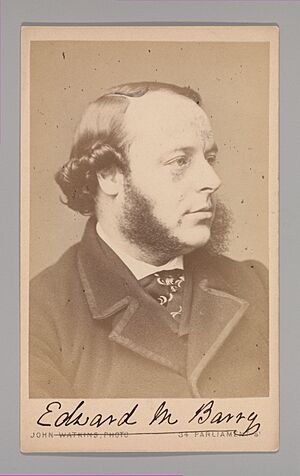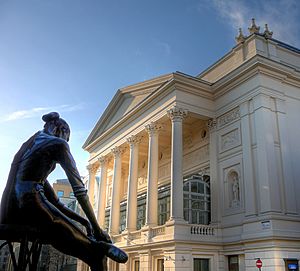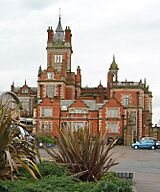Edward Middleton Barry facts for kids
Quick facts for kids
Edward Middleton Barry
|
|
|---|---|
 |
|
| Born | 7 June 1830 |
| Died | 27 January 1880 (aged 49) |
| Alma mater | King's College London |
| Occupation | Architect |
| Buildings | Royal Opera House (London) Royal Opera House (Valletta) St Dunstan's College |
Edward Middleton Barry (born June 7, 1830 – died January 27, 1880) was a famous English architect from the 1800s. He designed many important buildings, especially in London. You might know some of his work, like the Royal Opera House in Covent Garden. He also helped finish some of his famous father's projects, including parts of the Houses of Parliament.
Contents
Edward Barry's Early Life and Career
Edward Barry was born in London on June 7, 1830. He was the third son of Sir Charles Barry, who was also a very famous architect. As a child, Edward was often sick. He went to school in Blackheath and then Walthamstow. Later, he studied at King's College London.
Edward learned about architecture by working with Thomas Henry Wyatt for a short time. After that, he joined his father's architecture business. He helped his father until Sir Charles died suddenly in 1860. But Edward had already started working on his own projects.
Becoming a Recognized Architect
In 1848, Edward began studying at the Royal Academy. Even while helping his father, he found time for his own designs. His first building was St. Saviour's Church in Haverstock Hill, built in 1855–56.
His designs for St. Giles's schools in Endell Street, finished in 1859–60, really showed his talent. These projects helped him become an associate of the Royal Academy in 1861. This was a big step in his career.
Rebuilding Covent Garden
In 1857, the theatre at Covent Garden was destroyed by fire. Edward quickly rebuilt it in just eight months. The next year, he built the Floral Hall next to it. These projects showed his energy, building skills, and artistic talent.
These works were for his own clients. They did not stop him from helping his father. When Sir Charles Barry died in 1860, Edward took over finishing his father's projects. The most important of these was the new Palace of Westminster (the Houses of Parliament). He also completed Halifax Town Hall.
Later Life and Achievements
On March 29, 1862, Edward married Lucy Kettlewell. For the rest of his life, he designed many important buildings across the country. In 1869, he was elected a full Academician at the Royal Academy.
He also became a professor of architecture at the Royal Academy in 1873 and again in 1878. In 1874, he was made the treasurer of the academy.
Edward Barry's Famous Buildings
One of Edward Barry's most important buildings in London is the Royal Opera House in Covent Garden. The old theatre had burned down in 1857. Edward was chosen to design the new "Royal Italian Opera," as it was called then. It opened officially on May 15, 1858.
He also designed the Floral Hall, which was next to the Opera House. It was made of glass and cast iron. This design was inspired by the famous Crystal Palace from the Great Exhibition of 1851.
Edward's work at Covent Garden was very important. It led to him being chosen to design the Royal Opera House in Valletta, Malta, in 1866. This building was later damaged during World War II. Edward Barry often used a very classic style in his designs.
Other Notable Projects
Edward Barry worked on many other buildings. Here are some of them:
- St Saviour's Church in Hampstead, London (1856)
- Birmingham and Midland Institute (1855) – This building was later taken down.
- Leeds Grammar School (1857) – Now part of the University of Leeds.
- St. Giles's Schools, Endell Street (1860)
- Halifax Town Hall, West Yorkshire (completed by Edward in 1863, after his father's design)
- Royal Opera House, Valletta, Malta (1864)
- Charing Cross Hotel and the nearby Queen Eleanor Memorial Cross in London (1865)
- Cannon Street Hotel (1866)
- St Dunstan's College (1867)
- Rebuilding and adding to Crewe Hall, near Crewe, Cheshire (1866–70)
- Work on the Palace of Westminster (Houses of Parliament) in London. He finished his father's work in 1870. Edward was fully responsible for the colonnade and railings around New Palace Yard. He also worked on the Queen's Robing Room and the Central Octagon Hall.
- Sudbury Hall, Derbyshire (additions) (1872)
- Wykehurst Place, near Bolney, West Sussex (1872)
- The East Range of Downing College, Cambridge (1873)
- Peterborough Cathedral, pulpit (1874)
- The Hospital For Sick Children, (Great Ormond Street Hospital), London (1872) – His St Christopher's Chapel (1875) from this hospital still stands.
- New galleries and a dome for the National Gallery, London (1876). These are sometimes called 'The Barry Rooms'.
Final Works
Near the end of his life, Edward Barry started working with his oldest brother, Charles Barry, Jr.. They worked together on projects like the Temple Gardens chambers at Inner Temple, London (finished in 1879). They also designed the Great Eastern Hotel at London’s Liverpool Street station. This hotel was completed in 1884, after Edward's death.



